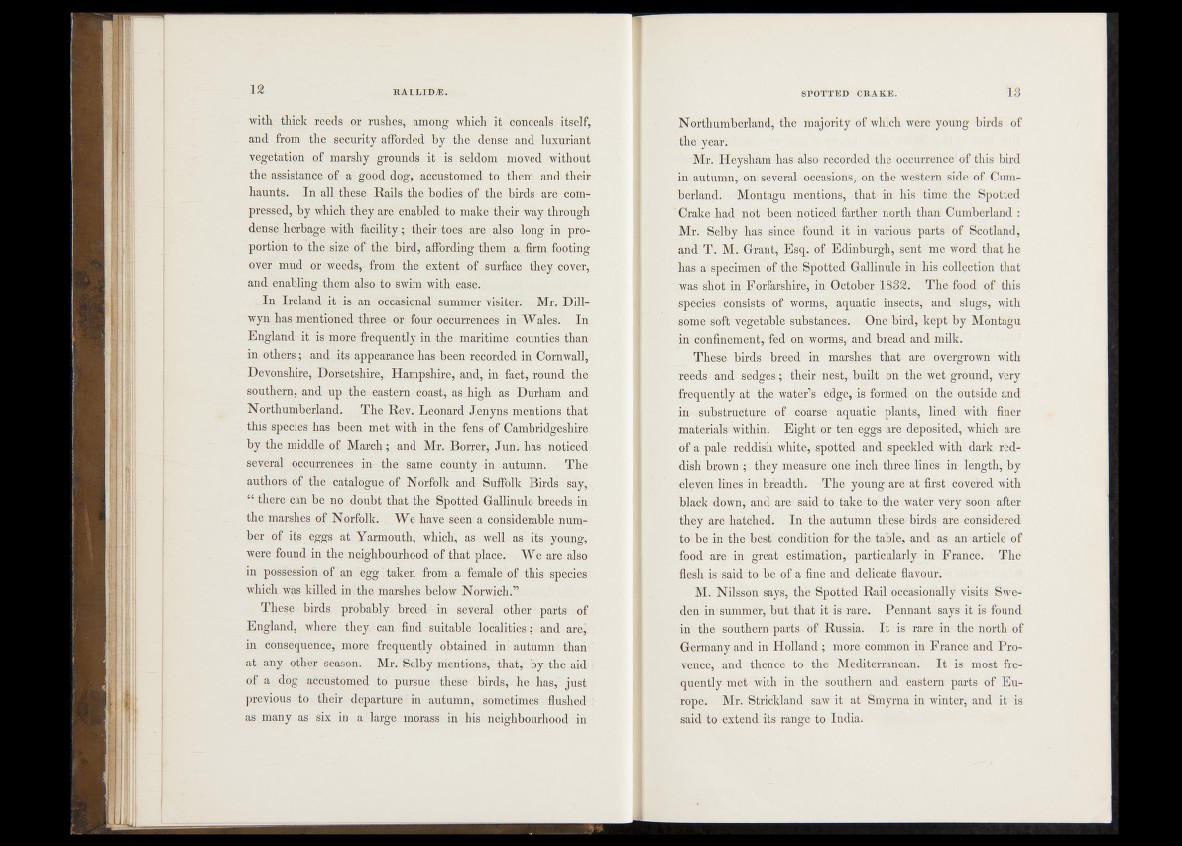
with thick reeds or rushes, among which it conceals, itself,
and from the security afforded by the dense" and luxuriant
vegetation of marshy grounds it is seldom moved without
the assistance of a good dog, accustomed to them and their
haunts. In all these Rails the bodies of the birds- are compressed,
by which they are enabled to make their way through
dense herbage with facility; their.toes, are also.lqng in proportion
to the size of the bird, affording them . a firm footing
over mud or weeds,- from the extent of surface they cover,
and enabling them also to swim with ease.
In Ireland it is a n , occasional summer visiter. Mr. ,Dill-
wyn has mentioned three or four occurrences in Wales. In
England it is more frequently in the maritime counties .than
in others; and its appearance has been recorded in Cornwall,
Devonshire, Dorsetshire, Hampshire, and, in fact, round the
southern, and up the- eastern coast, as high as Durham and
Northumberland. .The Rev. Leonard Xenyns. mentions that
this species has been met with in the fens of Cambridgeshire
by the middle of March; and Mr. Borrer, Jun. has noticed
several occurrences in the same'county < in autumn..-' - The*
authors, of the catalogue of Norfolk and Suffolk Birds say,
“ there can be no doubt that the Spotted Gallinule breeds in
the marshes of Norfolk. We have seen a coiisiderable.. number
of its eggs at Yarmouth, which, as well as its- young,
were found in the neighbourhood of that place« , We are also
in possession,of an 'egg' taken from a female of this species
which was killed in the marshes below Norwich.”
These- birds probably breed--in several other parts of
England, where they can find, suitablèf'üocalities ; and arey
in consequence, more frequently obtained in" autumn than :
at any other season. Mr. Selby mentiofis,’.that,' by the aid ^
of a ; dog accustomed to pursue these 'birds, he has, just
previous to their departure; in autumn, sometimes flushed ;
as many as six in a large , morass in his neighbourhood in
Northumberland, the majority of which were young birds of
the year.
Mr. Heysham has also recorded the occurrence of this bird
in autumn, on several occasions,; on the western side of Cumberland.
-Montagu mentions,^ rthab in his time the Spotted
Crake had not been-noticed farther north than Cumberland :
Mr. Selby has since; found it in various parts ‘ of Scotland,
and T. M. Grant, Esq. of Edinburgh'^sent me word that he
has a specimen of the-Spotted Gallinule in his collection that
was shot in Forfarshire* in October 18S&U The food of this
species ■ consists- of worms,' aquatic insects, and .Slugs, with
some soft vegetable substances. One bird, kept by Montagu
in.'confinement,’fed on worms, and bread and milk.
These birds breed ’ in marshes that are overgrown with
reeds and sëdgess, their nest,.built on the''wet ground, very
fi?e<|uently at the water’s efigfeyik- formed ,bii' the outside and
in ■ substructure of coarse’ aquatic^ plants, ■ lined with finer
materials; within. Eight pr témëggs are deposited, which are
of a pale reddish white, spotted and speckled with dark reddish
brown ; they measure one inch three lines in length* „by
e|e^en lines in breadth.- The young are at first .'hovered with
black down, and are* said! to take'to; the water yery soon after
they are hatched. In the autumn these birds are considered
to be in the 'besffe-cpndition for the table, and as an article of
food are in great estimation, particularly in Francé. ■: The
flesh is said to’ be of a fine and delicate flavour.
: M. Nilsson says, the Spotted Rail occasionally visits Sweden
in summer, but that i%-is rare. Pennant says it is found
in the southern parts bf Russia. It is rare in the north of
Germany and in Holland ; more common in France, and Provence,
and thence to the'1 Mediterranean . I t is most frequently
met with in the southern and eastern parts of Europe.
Mr* Strickland saw it at Smyrna in winter, and it is
said to extend its range to India.